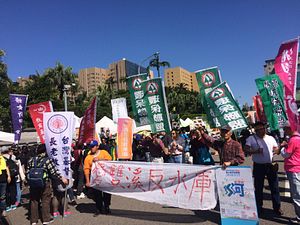Nestled between neon blue waves lapping against the rocky coast and jade green mountains rolling into the distance, from afar Taiwan’s Second Nuclear Power Plant looks to be the picture of tranquility. It is only upon approaching the facility that one notices the two dozen armed police officers walking around the premises. A nervous-looking receptionist waits in the lobby to assure guests that nothing is awry. “Today is the anniversary of the accident at Fukushima. We are preparing for protesters.”
The startling number of law enforcement officers at the power plant gives testament to the embattled history of nuclear power in Taiwan. Step into any trendy coffee shop or burger joint in the country and, among the vintage collectables and polaroid pictures, there is a good chance you will see an off-white cloth banner hanging on the wall, screen-printed with a turquoise outline of Taiwan, and bearing a simple message; “No nukes. No more Fukushima.” Indeed, the infamous Japanese nuclear accident in 2011 galvanized major protests across Taiwan, halting the construction of the country’s fourth nuclear power plant and casting it into a political and legal limbo.
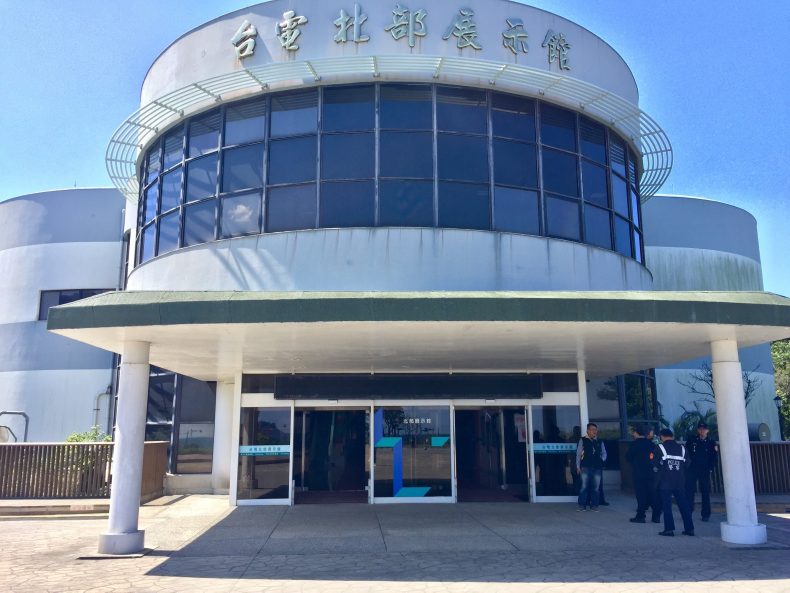
Several police officers stand guard in front of the visitor’s center of the Second Nuclear Power Plant on the seventh anniversary of the Fukushima accident. Recent moves by Taipower to reopen the plant’s second nuclear reactor sparked concerns of protest. Photo by Jenna Nardi.
Last month, a 7.3 magnitude earthquake off the east coast caused major damage in the vacation city of Hualien, only 120 kilometers from the site of this nuclear plant in New Taipei county. The incident reminded many Taiwanese why they fought so long and hard to block its completion. With a landmass less than a tenth the size of their northern neighbor Japan, how would Taiwan deal with quarantining part of their small island home in the event of a true nuclear catastrophe?
This is exactly the type of concern that brought hundreds to the streets of Taipei on March 11 as they united to protest the move by Taipower, Taiwan’s state-backed power monopoly, earlier this month to bring the second reactor of its Second Nuclear Power Plant back online. The reactor has been on a two-year hiatus, brought on by a short circuit in 2016. The unfortunate coincidence of this decision with the seven year anniversary of Fukushima presented the perfect opportunity for no-nuke protesters to mobilize. Taipower declined to be interviewed, citing the sensitivity of the issue. The shiny new display in their visitor’s center, which specifically highlights the differences between Taiwan’s nuclear power plant designs and the Fukushima Daiichi power station, gives a clue to their stance.
The anti-nuclear movement in Taiwan far predates the events of 2011. Organized action against nuclear power can be found as far back as Chernobyl in 1986, during a time when anti-nuclear and pro-democracy forces found common cause in opposing the Nationalist Party, or Kuomintang (KMT). The KMT, which ruled Taiwan under martial law for decades, had constructed three nuclear power plants, with designs for a fourth underway. The Democratic Progressive Party (DPP) incorporated opposition to nuclear energy into their political platform, and as such, many activists were encouraged when the DPP’s Chen Shui-bian won the 2000 election. Their hope was that the transfer of power would not only end a half-century of continuous KMT rule but terminate Taiwan’s nuclear energy program for good.
Indeed, Chen’s administration halted construction of Taiwan’s fourth nuclear power plant immediately after coming into power. However, the hope proved short lived. Mere months later, Chen walked back on his promise and allowed construction of the plant to resume, citing the need for stability in a country undergoing a political transformation. The move greatly slowed the momentum of the anti-nuclear campaign.
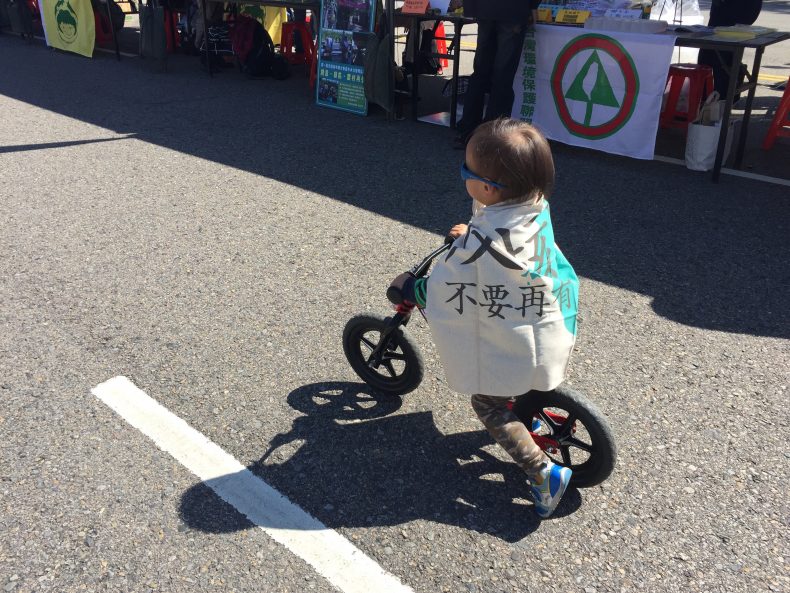
A toddler rides a tricycle through the March 11 protest, wearing an anti-nuclear banner as a cape. The banner, which reads “No nukes. No more Fukushima,” can be found adorning the walls of trendy coffee shops across Taiwan. Photo by Jenna Nardi.
In the years that followed, protests against nuclear energy continued to boil up from time to time, but with limited political consequence. In 2002, over 2,000 people, many of them indigenous, protested the nuclear waste storage facility on Orchid Island, a two-and-a-half-hour ferry ride from the southern city of Taitung. The waste was stored on the island for decades, for a time without the residents’ knowledge or consent. Taipower has supposedly sought out overseas deposits for the waste, but as of now it remains on the island.
Yang Kang, a university student and Taipei native at the protest, outlined why threads of the democratic history of Taiwan continue to be deeply entangled with the nation’s relationship to nuclear power. “The main reason why I’m here is because I want to make the question of nuclear power remain a political one,” Yang explained. “I think that people should have the mobility and the agency to go into the discussion about nuclear power.”
While the anti-nuclear movement in Taiwan mimics many similar environmental crusades in the West, there are a number of unique circumstances surrounding the island’s geopolitical and environmental position which should give no-nuke activists reason for pause. Even as Taiwan’s young people sit in cafes lined with anti-nuclear banners, they may very well be breathing in the poisonous side-effects of their activism. The recent rise in air pollution is rumored to be related to the uptick in coal production accompanying the current Tsai administration’s nuclear phase out.
Fossil fuels, such as coal, oil, and LNG, are increasingly imported from mainland China, as well as from Africa and the Middle East, on routes passing through the contentious South China Sea. As Taiwan imports over 97 percent of its energy, the island is in an increasingly vulnerable position even as threats and aggression from the mainland grow. In the event of an embargo or, in the worst-case scenario, an armed confrontation, how long could Taiwan run its energy-intensive economy, let alone its military, on its limited backup reserve of fossil fuels?
In World War II, Japan’s infamous kamikaze strategy was driven largely by a dwindling fuel supply as the island empire lost its ability to conduct war. Without a carefully considered energy mix, Taiwan could find itself in an all-too-similar situation in the event of a military struggle. Some experts give the island about a month before things start to fall apart. Nuclear energy could potentially provide an alternative form of power generation, prolonging Taiwan’s ability to hold out before receiving outside assistance.
While the Chinese threat looms as large as ever, it is the smoggy side-effect of the imported coal which more likely weighs on the mind of the average Taiwanese from day to day. Even the most seasoned anti-nuclear advocate in Taiwan might soften their outlook after a few days of breathing heavy smog and reading over the accompanying health statistics.
Air pollution has grown to be one of the world’s largest health issues, giving rise to a litany of chronic diseases that kill 6.5 million people a year, according to the World Health Organization. In Taiwan, there were reportedly 6,000 air-pollution related deaths in 2015. An app called AirVisual is growing in popularity in Taiwan. It shows alarming levels of air pollution down the entire length of Taiwan’s west coast, where most of its population is centered.
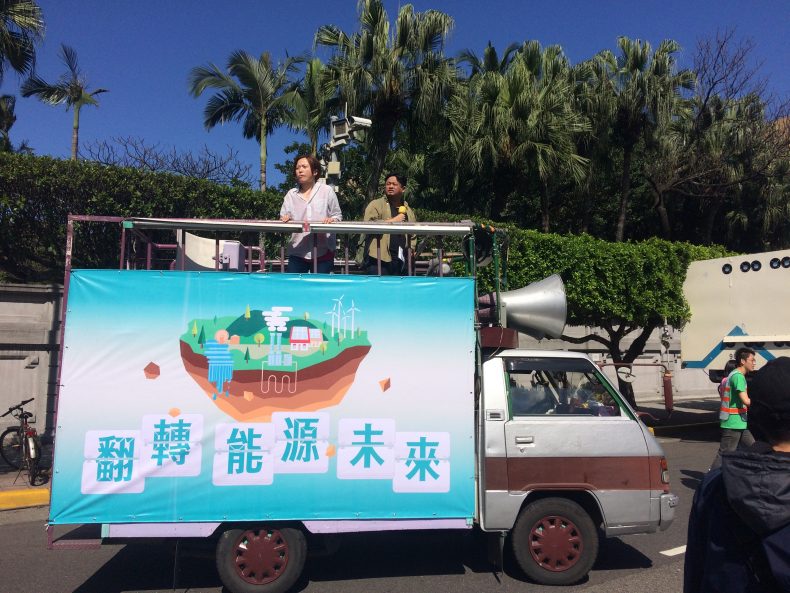
Protesters in Taipei gathered on March 11 to oppose the move by Taipower to restart a reactor at the nuclear facility just north of the city limits. Green Citizen’s Action Alliance, a leading anti-nuclear group in Taiwan, followed the march in a truck displaying cartoon renditions of clean energy technologies. Photo by Nicolas Freschi.
Hong-chang Yo, who overseas air quality control for the Changhua County Environmental Protection Bureau, denies that reducing nuclear power is causing a rise in smog. “It is said that a decrease in nuclear power generation will lead to a proportional increase in coal-fired thermal power. This is not necessarily the case.”
Instead, Yo points to statistics indicating decreasing levels of air pollution in his county over the last four years. “The current government policies are pushing ‘green’ energy and renewable energy.” These policies, Yo insists, will lead to decommissioned nuclear plants being replaced by cleaner sources of power.
The protestors at the anti-nuclear rally in Taipei seemed to agree. The speakers stood on a stage in front of a formidable solar panel array and drove trucks with cartoon images of renewable energy adorning the sides. Kang lays out the protestors’ position: “We are trying to replace nuclear power with renewable energy. And I think that it is possible in Taiwan. Taiwan has a lot of wind power, solar energy, and heat from the ground, so I think that Taiwan has a lot of potential for developing renewable energy.”
Even Taipower, the sole operator of all of Taiwan’s nuclear and fossil fuel plants, does not want to be left out of the hype surrounding renewable energy. The entire upper floor of the Second Nuclear Power Plant’s visitor center is dedicated to educating the public on the various clean energy technologies being developed around the country. Yet for those taking to the streets like Kang, this is not enough. “I think the government is not doing their responsibility to try to find the third way for us,” Kang states, waving away the suggestion that there is a dichotomy in Taiwan between nuclear energy and fossil fuels.
However, in contrast with a nation like the United States, which has vast amounts of land to spread out renewable energy sources, Taiwan’s size and population density prohibit it from even theoretically running on 100 percent solar and wind power. As such, the island needs to think realistically about how it can reduce its air pollution even as its economy grows, or risk increasingly worse smog in years ahead. Is the threat of a nuclear meltdown truly as ominous as the present and oppressive poisonous clouds that have descended on the island?
The 2016 election of Tsai Ing-wen again ignited hope for anti-nuclear crusaders. She won on a platform of denuclearization by 2025, a goal which she seems to be making scant progress toward. The Taiwan’s Atomic Energy Council approval of plans to restart the reactor at the Second Nuclear Power Plant emphasizes this point. The reasons for the reverse in position? Growing alarm over air pollution and energy security.
As the decrease in nuclear energy drags Taiwan towards geopolitical vulnerability and physical ailment, it is time for the nation to begin to seriously consider its options. This means sifting through decades of entrenched feelings and politicized debates to find the objective realities of nuclear power.
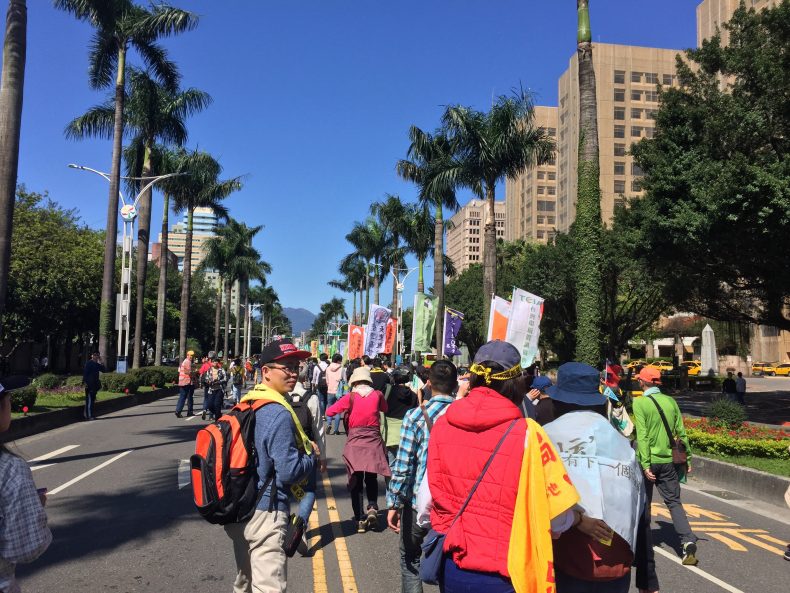
A diverse coalition of over a thousand protesters marched through the streets of Taiwan on Sunday, March 11 to oppose the restarting of a nuclear reactor at Taiwan’s Second Nuclear Power Plant. Photo by Jenna Nardi
There is one group in Taiwan that is doing just that. Nuclear Mythbusters, a community of pro-nuclear students and scientists, uses slogans like, “Go Green with Nuclear” and “Choose your power, and fight in the name of Science & Truth!” The group was founded at National Tsing Hua University by students in Taiwan’s only educational department dedicated to nuclear engineering and science, in the months following the events of Fukushima. The group now boasts almost 30,000 online members, many from science and engineering backgrounds, and active forums to discuss energy policy.
Nuclear Mythbusters breaks away from the long tradition of anti-nuclear sentiment in Taiwan in their effort to understand the “truth of energy.” Chong Yie Chang, who acts as the group’s COO, outlined the organization’s objectives. “The most important issue is energy security. The second is energy growth. The third is sustainability. People need energy for 1,000 or 2,000 years. Neither fossil fuels nor renewable energy are sustainable for 1,000 years.” For Nuclear Mythbusters, nuclear is the only long-term option.
Chang clarified, however, that the group does believe renewable energy is good, just that people need to avoid the myths surrounding renewables. Renewables, the group believes, lack economic viability without government support. “The government should not control the market,” Chang emphasized. “We believe in small government.”
The trick for Nuclear Mythbusters is getting the government to believe in them. The group, while largely existing online, has used lobbying and educational events around Taiwan to persuade both politicians and the public of the benefits of nuclear power. They even pressured both candidates during the 2016 election to share their stances on nuclear energy.
Perhaps their efforts are having some effect. Once associated with the pro-nuclear politics of the KMT, many people now believe that Nuclear Mythbusters is sponsored by the DPP, as a form of justification for their flip-flop on nuclear campaign promises. The nonpartisan group tries to avoid the politics and focus on the facts, but Chang could not help but weigh in on Tsai. “Everybody realizes Tsai Ing-wen is bullshitting. She is trying to pretend that there is no electricity shortage even though everybody knows that the shortage is coming,” Chang complained. “She always claims that we should care about carbon emissions, but everybody knows that she is actually increasing the carbon emissions because there are more and more fossil power plants in Taiwan.”
It would be easy to dismiss Taiwan’s nuclear dilemma as simply a matter of being stuck between a rock and a hard place, and perhaps for any other nation it would be just that. But the Taiwanese people possess an intelligence, a resourcefulness, and an affinity for geopolitics that exists in a class of its own.
To navigate through this challenging moment, each facet of Taiwanese society must play its part. The anti-nuclear activists should recognize the limitations of renewable energy for Taiwan, the dangerous side effects of relying on fossil fuels, and the vital role nuclear energy plays in maintaining their government’s democratic independence.
The Tsai administration could demonstrate to activists that, while nuclear power may be a necessary component of the nation’s energy supply, steps will be taken to assure it is used in the proper way. This may include following up their apology to the Tao people of Orchid Island with the removal of the waste there to a final storage facility overseas.
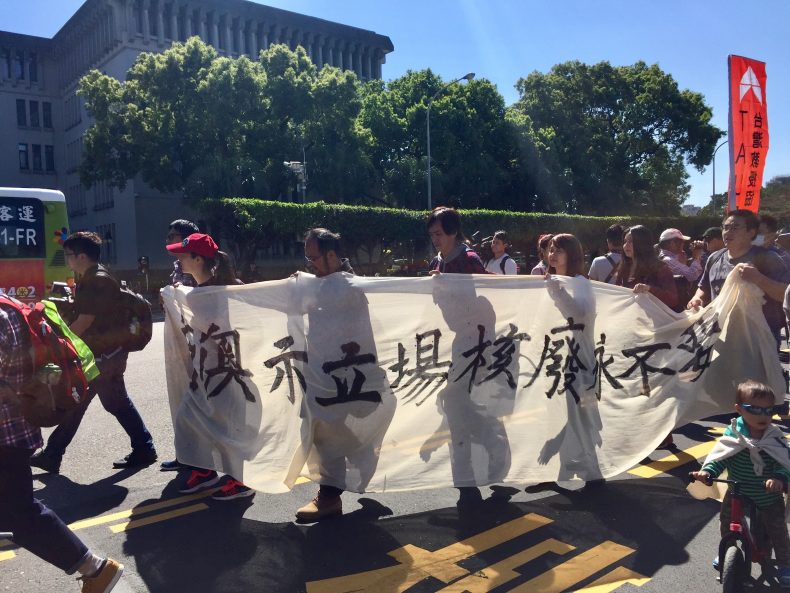
Nan’ao Township, from Taiwan’s east coast, displaying their anti-nuclear stance. Photo by Jenna Nardi.
Perhaps Taipower, its government administrators, and anti-nuclear activists could all compromise on completing the long fought-over fourth nuclear facility and making upgrades to the existing plants to assure they can operate in the safest way possible. What is more important, however, is for Taipower and its government administrators to recognize the critical importance of fulfilling their promises and leaving important decisions over the fate of the country to its citizens.
The Taiwanese are right to look at Fukushima, as well as other nuclear disasters, and have concerns about the safety of their own nuclear power stations. The recent earthquake certainly highlighted this fact. However, the historic fusion of anti-nuclear and anti-authoritarian zeitgeist must be left in the past. The Taiwan of today faces new threats, of asphyxiating air pollution and energy vulnerability, which nuclear power would do much to alleviate.
The battle over Taiwan’s nuclear future does not look like it will be resolved any time soon. Whether the pro-nuclear rhetoric of the Nuclear Mythbusters or the anti-nuclear marches like the one that filled the streets of Taipei on Sunday ultimately win out, both sides can agree on at least one thing. Kang put it eloquently.
“I mean, anti-nuclear and pro-nuclear, it is a democratic issue. The reason why I’m here in this movement, in this rally, is that I believe in the values of democracy, and I think that we should leave the question of nuclear power not for scientists and technocrats, but to the people.”
Nicolas Freschi is an entrepreneur and advocate in the clean energy industry and currently lives in Taiwan.













